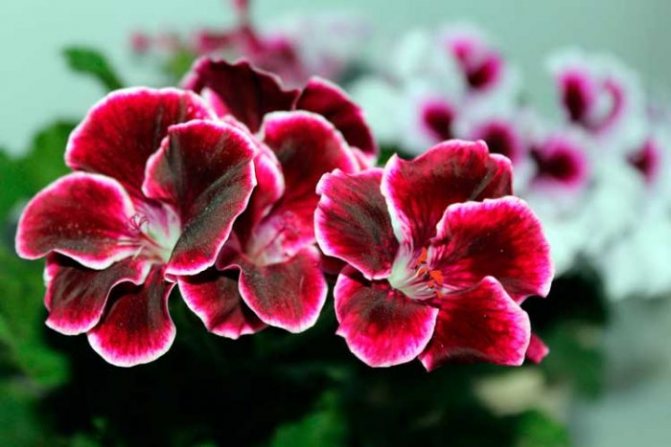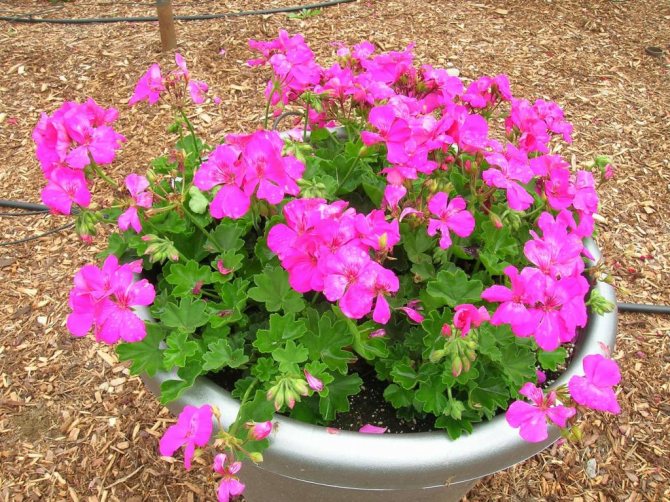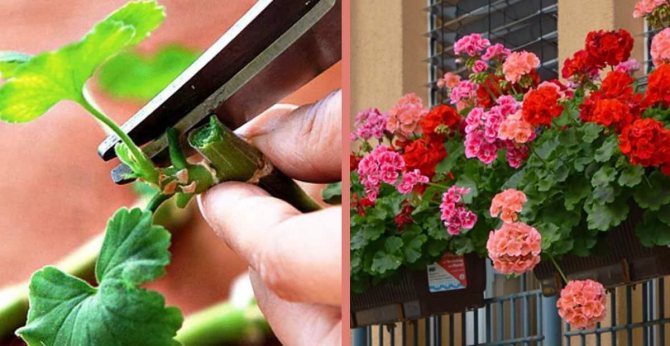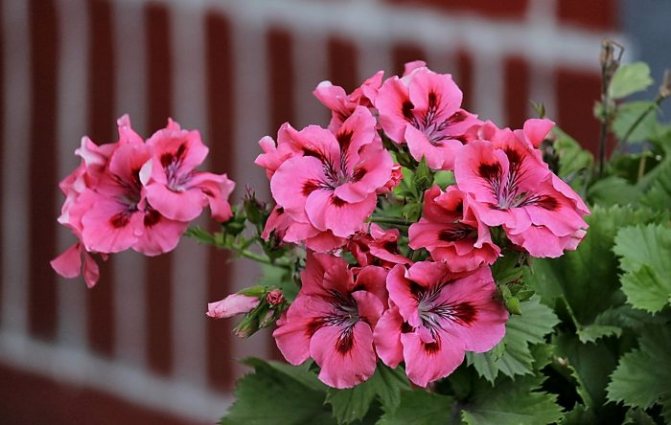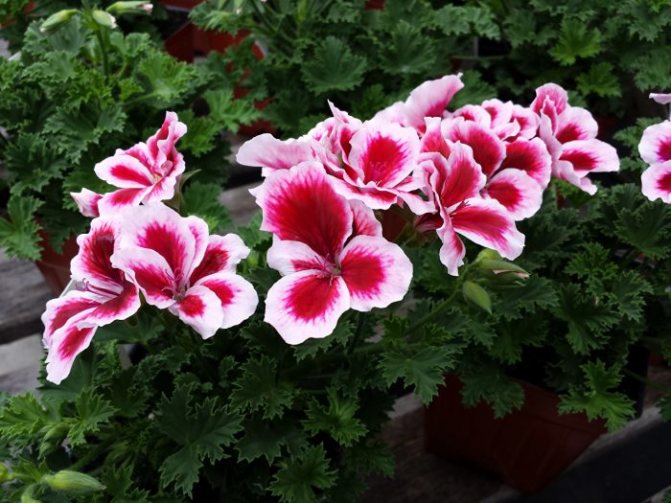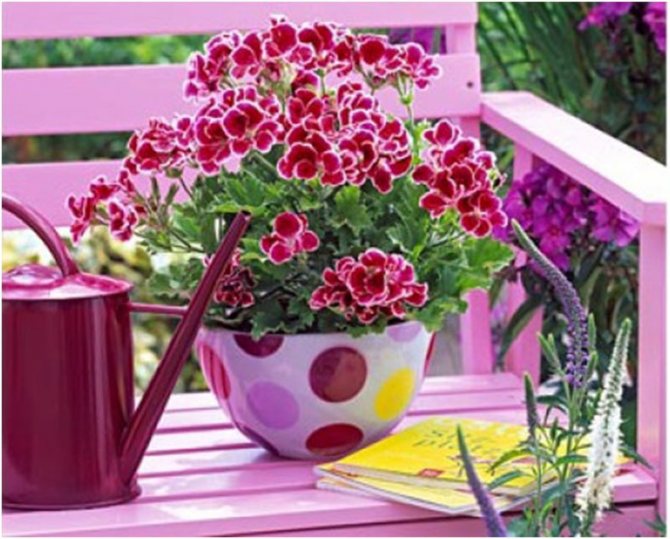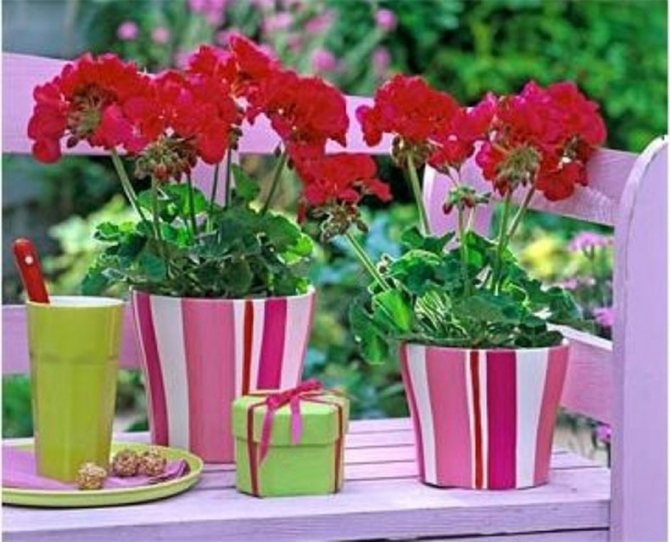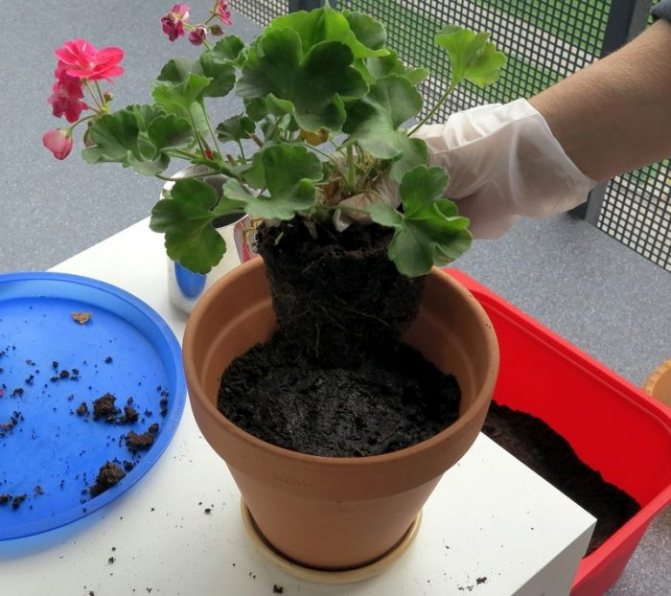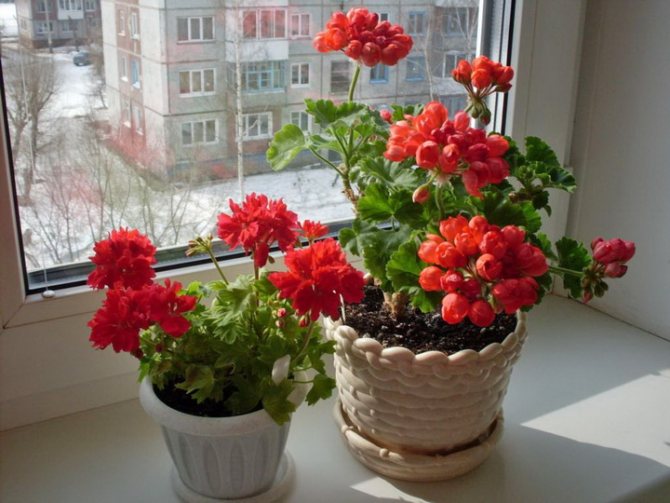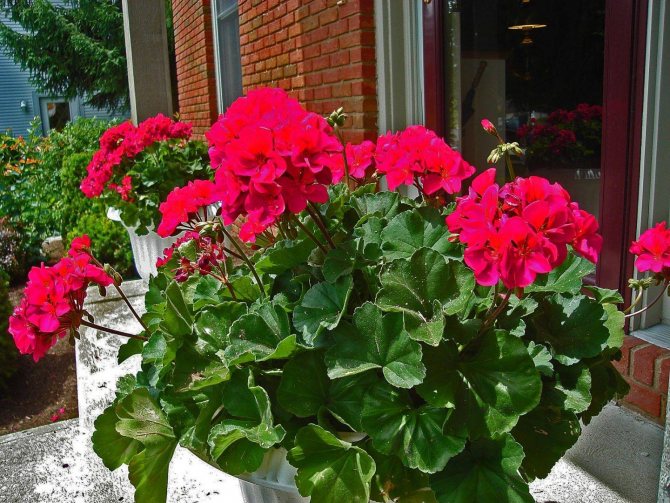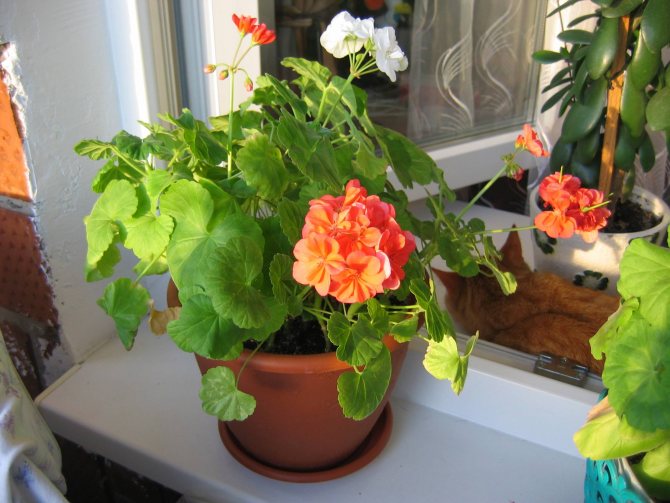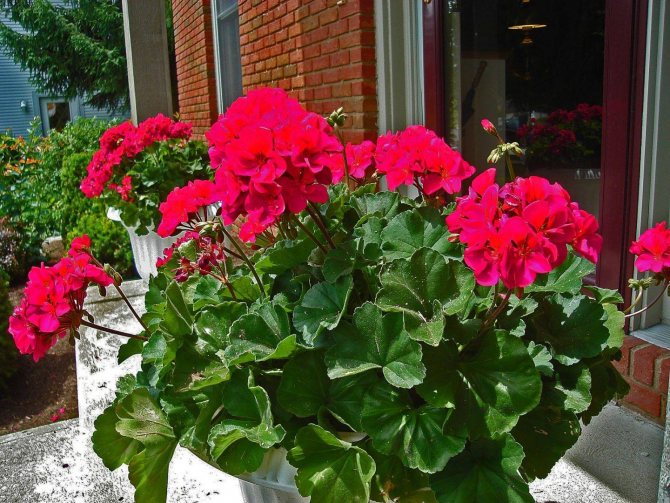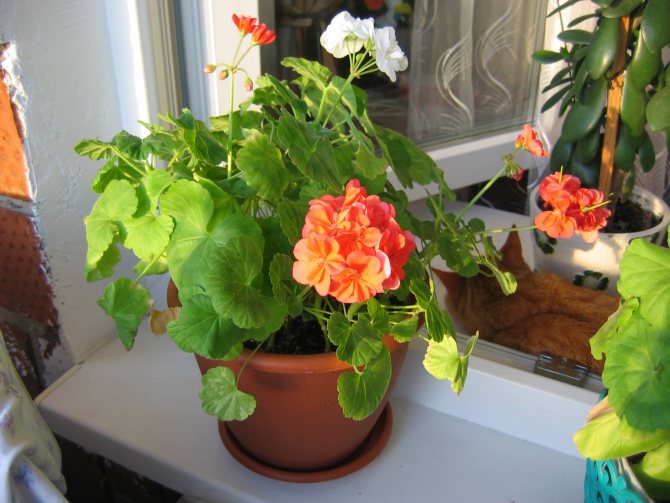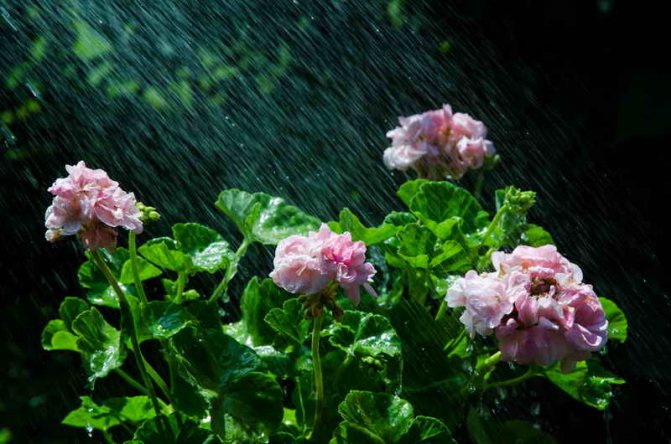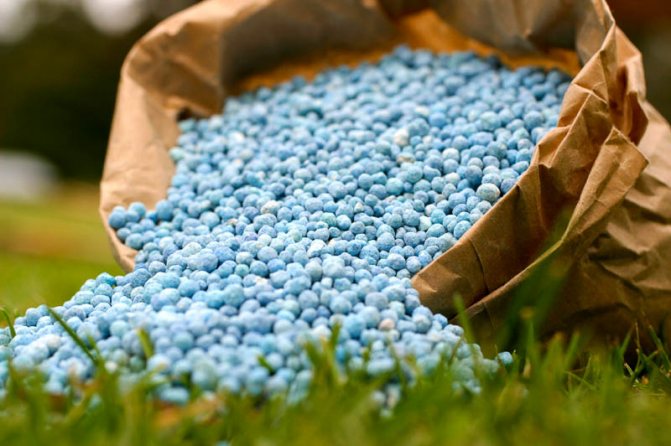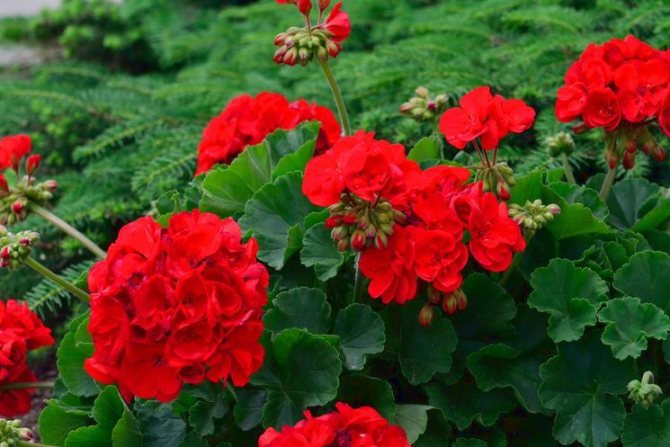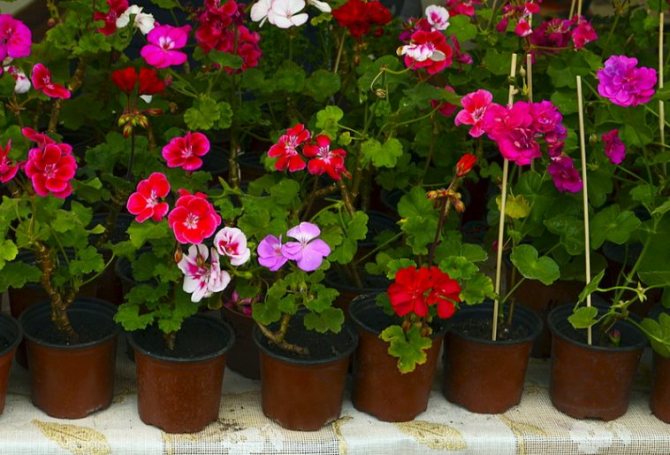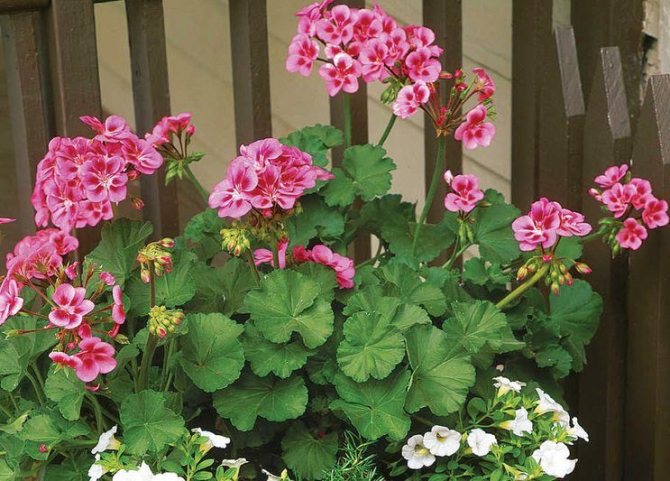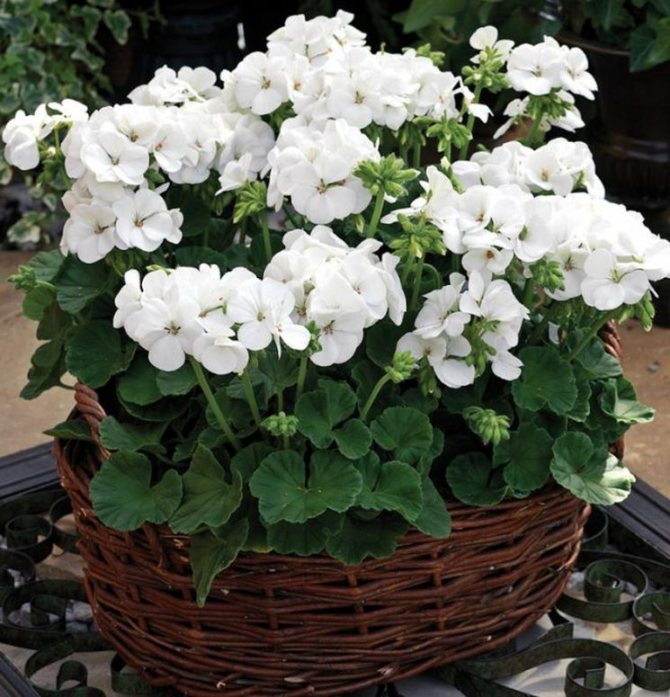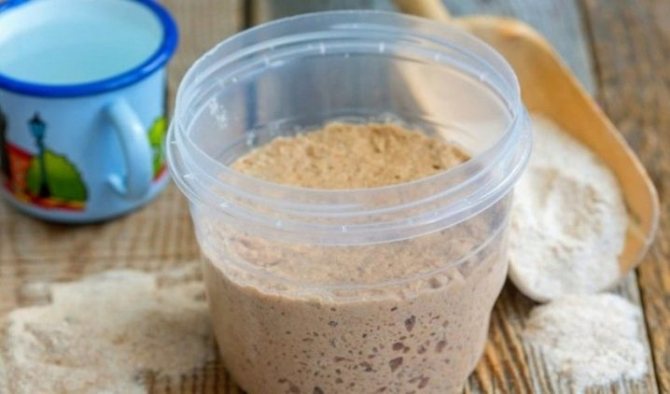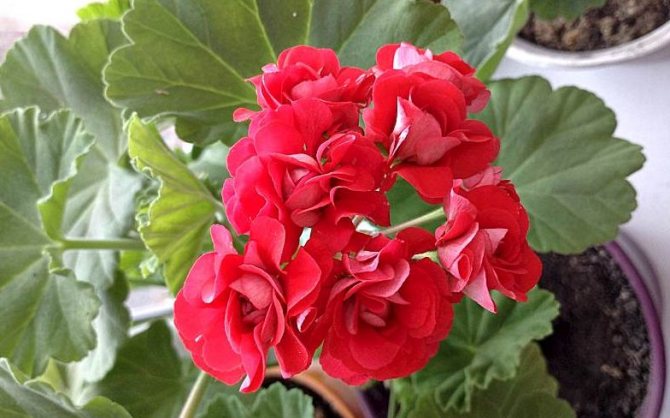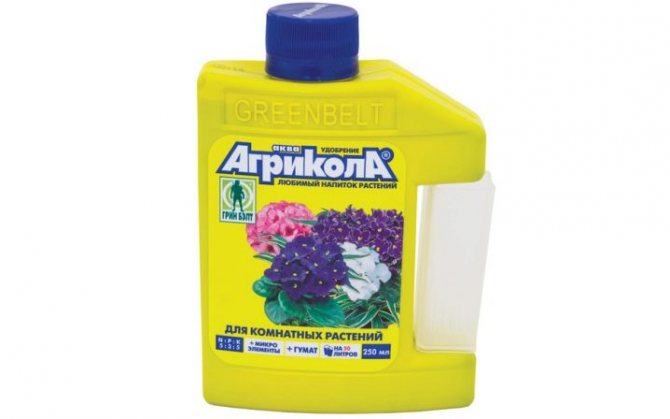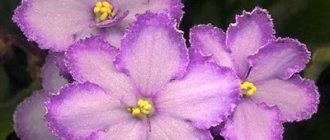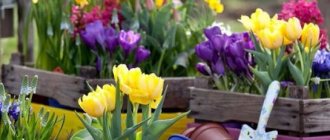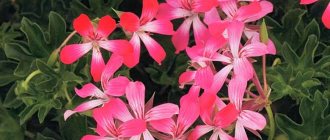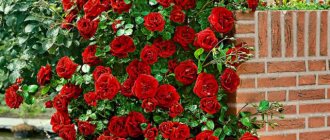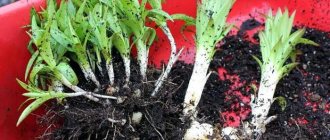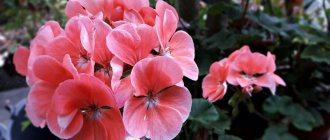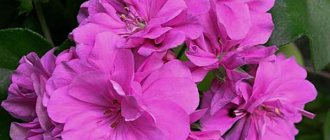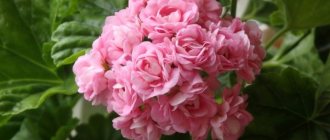Geranium, or pelargonium, is a popular plant among flower growers. For healthy development and good bud formation in a flower, it is necessary to properly care for it and introduce nutrients into the soil in a timely manner.
Growing geraniums. Illustration for this article is used under a standard license.
As a fertilizer, both ready-made preparations and affordable folk remedies are used.
Popular varieties
Geranium is a very beautiful plant with a pleasant aroma. Thanks to its variety, you can choose a bush with colorful buds, different leaves and flower shapes. Although among domestic lovers of pelargonium, only a few of its varieties are popular.
- Fragrant geranium. It has a low stem and a fluffy crown. Has an unobtrusive pleasant aroma.
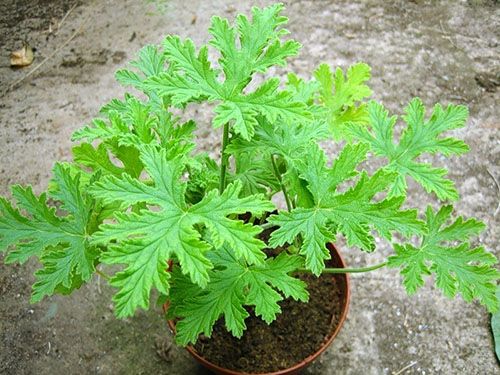
- Royal geranium. Tall plant with beautiful dense inflorescences. True, royal pelargonium does not bloom for very long.
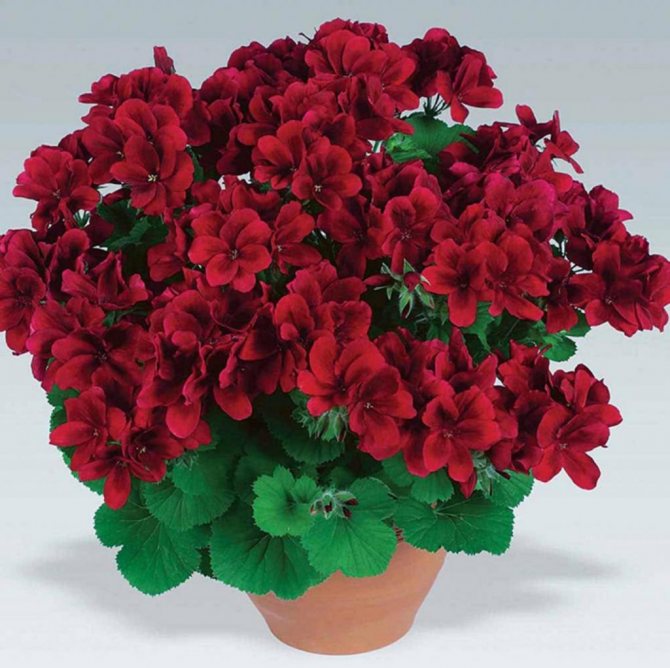

- Geranium is zonal. The most popular plant, which has small, dense inflorescences and leaves with unusual circles. Flowers of such pelargonium are double and simple, and their color ranges from pale pink to deep red.
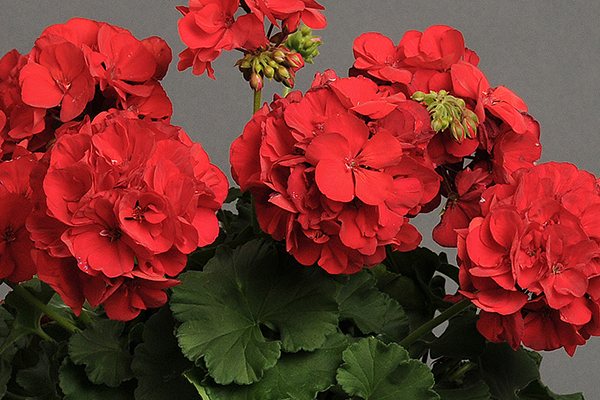

- Geranium "Angel". It grows up to 35-40 cm. Stripes or dot patterns appear on the upper petals of this geranium. Flowers at "Angel" are different: snow-white, purple, pink, red. Geranium of this variety blooms all summer and is considered one of the most unpretentious species.
- Pelargonium "Unicum". Reaches half a meter in height. It has a double color of flowers: the petals are white in the middle, and purple or red at the edges. This variety has large, dark green leaves.
- Ampel geranium (ivy). It grows up to a meter, has leaves that look like ivy, which actually owes its name. Flowers can be of any color, from pure white to deep blue. Inflorescences are large, double and simple.
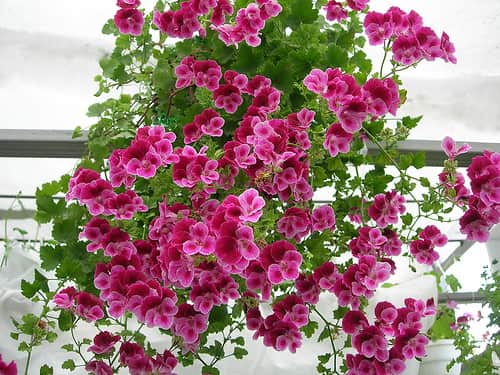

As you can see, there are many options. So you can easily choose a flower to your liking.
How to pinch pelargonium
- Pinching is done with a sharp, sterile instrument. Hands should also be clean, you can work with gloves;
- If the pinching is done with your hands, then you do not need to pull the plant;
- Before the procedure, you need to inspect the plant and find the growth point. It is she who needs to be pinched so that the trunk does not stretch. If the tip is young and soft, then pinch it with your fingers, if - lignified - with a sharp blade;
- After the procedure, the plant is immediately exposed to a sunny place;
- All branches that thicken the bush, that is, those that grow inward, are subject to removal. Too thick crown impairs air exchange and provokes the development of diseases;
- If the distance between the leaves is too large, the bush looks bare, then the pinch is done over the leaf;
- If the pinching is done for sanitary purposes, then pinch the diseased branch together with the healthy area (4 cm);
- The place of pinching must be rubbed with charcoal;
- So that the plant does not weaken, the pinching is done in several stages, giving time to recover.
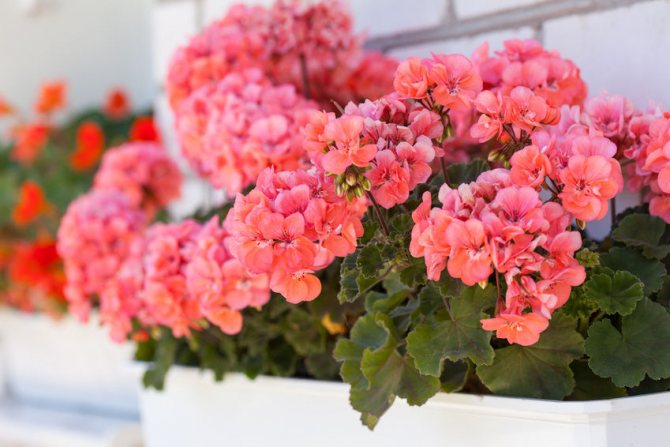

Types of pelargonium
Landing features
By growing a flower from seed, you will have a viable, sturdy plant that will often delight you with abundant flowering. You can find a huge assortment of pelargonium seeds in the store, but note that not all of them are suitable for growing at home.
It's all about the specifics of selection. Flower hybrids are obtained through cross-pollination, due to which plants become owners of unique properties. They get an unusual shape or shade of leaves, the most amazing colors of buds. But these features are not passed on to subsequent generations, and not such flowers are obtained from the collected seeds. This is exactly what happens with rosaceous, royal, double and tulip varieties. So be on the lookout.
But you can buy zonal and ampel geranium seeds. By the way, ivy-leaved pelargonium has long hanging stems that allow it to be grown in crates or hanging containers on the terrace.
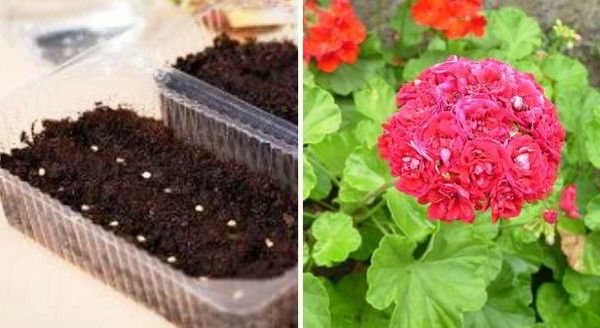

How to plant geraniums? If pelargonium grows in the room, then it can be sown at any time. However, spring is considered the best time to plant geraniums. Then pelargonium will have time to gain strength and blossom by summer. Indeed, it is in warm times that geranium develops most actively, and in winter it needs peace.
If you want to decorate a balcony or terrace with a plant, plant it in January, February or March. Then by summer it will delight you with its lush flowering.
How to feed blooming geraniums?
The easiest way out is to go to the store. Vendors will most likely offer you standard substrates for all flowering plants. Such nutrition will not harm the flower, but it does not guarantee good flowering either. To ensure good flowering, you need to choose the top dressing yourself.
Feeding with manure and iodine
Fresh manure is strictly prohibited; if you feed it, the plant will die. Feeding with manure is carried out if pelargonium is planted in open ground or on a loggia, balcony. It is brought in once every three weeks. After feeding, the leaves and flowers become brighter and stronger, the stem becomes stronger.
Watering with plain water is replaced by watering with iodine solution. After feeding, pelargonium begins to actively grow and bloom. Plain water is replaced by rainwater, it contains more nutrients.
In the video, a recipe for feeding geraniums for flowering:
Nutrition with nitrogen and vitamins
Fertilization rules:
- Nitrogen fertilizers are applied in early spring and before flowering. They stimulate the growth of leaves and buds. Meals are brought in every two weeks.
- Vitamins are bought at a pharmacy and diluted in water. The vitamin complex is changed every two weeks. Such food is much cheaper than special means.
- Magnesium sulfate influences the violent flowering. Crystals of this nutrient are dissolved in water and poured over with pelargonium.
- If the plant blooms and grows poorly, increase the amount of calcium in the soil.
- It is important to follow the enrichment sequence. It is necessary for the period of flowering and the period of budding.
How to plant geraniums correctly
Pelargonium seeds sprout easily even without additional preparation. But for insurance, they can be pre-processed.
First, the seeds need to be lightly filed with sandpaper or cut. Then they should be treated with a solution of potassium permanganate or fungicide to avoid decay.
You can germinate seeds in different ways:
- on a damp cotton pad or napkin;
- in special peat tablets;
- in the substrate.
You can make the choice at your discretion - they are all equally good.
Description of the plant
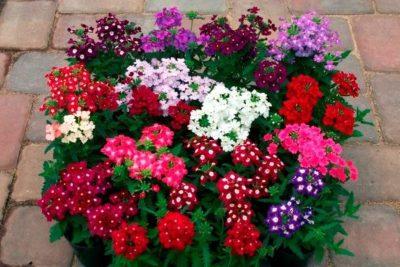

It is an annual and perennial plant. The height of the stems reaches 50 cm. The leaves are of a bright dark green color. The flowers of the plant are very beautiful and large. In some geranium species, they are collected in inflorescences. The leaves of the culture have a refreshing, mint and lemon scent. There is a pattern on the leaves, presented in the form of a white border or stripes of various colors.
Geranium is distinguished by incredibly beautiful flowering. Umbrellas of flowers are concentrated on a thin stalk, and the leaves look like a human palm. If the geranium does not have enough lighting, then its flowering decreases, and the leaves and flowers become faded.
Soil features
Most ready-made indoor plant substrates are suitable for growing pelargonium. You can make the mixture yourself by mixing sand, peat, and garden soil in equal proportions. Just don't forget about drainage. The best soil for geraniums easily allows air and moisture to pass through, and is loose.
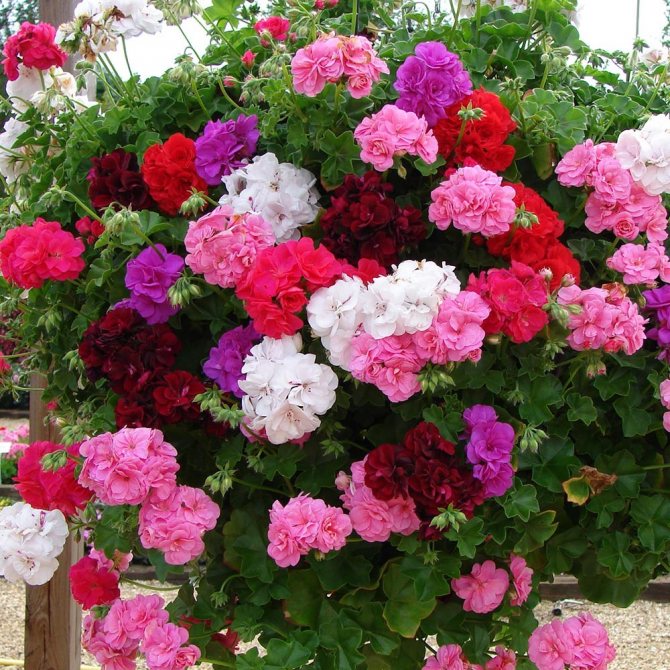

Seeds should be placed in the soil to a depth of one centimeter. In this case, the soil must be moist. Be sure to cover the top of the container with film, which will need to be removed periodically to avoid decay.
Precautions
When planning to apply fertilizers, you should know which trace elements geranium needs.
Otherwise, you can disrupt the soil balance and finally destroy the plant. Chemicals must be used very carefully. When working with them, you should wear protective gloves and goggles, and also strictly adhere to the instructions for use. If everything is done correctly and consistently, then with the help of chemical or folk dressings, you can create an optimal nutrient medium for flowering for geraniums.
Watering mode
In summer geraniums need to be watered moderately but frequently. Just keep in mind that the plant will not tolerate an excess of moisture and will die. Due to abundant watering, geranium leaves become too sluggish and begin to rot. If this occurs, be sure to cut back on watering. Otherwise, the root will soon begin to suffer.
But it is also dangerous to completely deprive geraniums of water. She will most likely endure drought, but lush beautiful flowers will no longer appear on her stems.
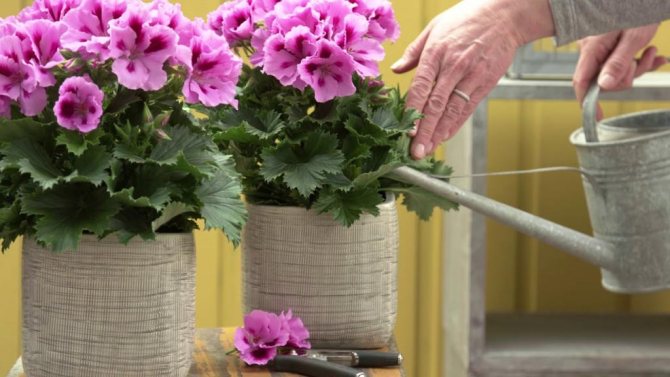

It is best to target the soil. As soon as you notice that it is dry, pour in the pelargonium. But giving her water unnecessarily is undesirable.
Features of care and fertilization of geranium
Pelargonium is an unpretentious plant.
The following nuances are taken into account in care:
- It is important for geraniums to provide good fertile soil.... Under such conditions, pelargonium will produce a minimum of greenery and a maximum of flowers. When transplanting, make good drainage.
- There is no need to spray the flower. It is important to provide fresh air. In the summer, it is recommended to take it out to the balcony or plant it in a flower bed.
- The place should be well lit. Direct rays will not harm the flower. It is removed from the sun only on particularly hot days.
- There are no temperature requirements. In winter, the recommended temperature is 15 degrees.
- Feeding with fresh organic matter is prohibited. The plant does not tolerate it.
- Iodine solution works very well. But it is brought in no more than 50 ml, otherwise the roots can be damaged.
Geranium feeding frequency
The frequency of feeding geraniums depends on the season. In winter, it is not necessary to feed the plant. And from the beginning of spring, they begin to feed the plant once every two weeks. This is especially important during the flowering period. In the autumn and winter period, the frequency of feeding is halved or completely removed.
How to feed geraniums so that the leaves do not turn yellow?
Pelargonium leaves may turn yellow due to several reasons:
- The flower grew from its pot... In this case, the plant should be transplanted into a larger pot. After which the problem should disappear by itself.
- Improper care will provoke yellowing of the leaves.... More often, pelargonium turns yellow due to drafts, too high temperatures in autumn, winter, and a large amount of moisture.
- There is no drainage in the pot. In such a plant, the leaves not only turn yellow, but also lose their color.
- Large amount of nitrogen fertilizers Is one of the most common reasons.In this case, the plant should be fed with potassium-phosphorus fertilizers.
Top dressing when transplanting
Geranium does not like transplants. If you constantly feed the plant, then transplanting is practically not required. Only if the flower has grown from a pot.
When transplanting, it is important to provide a drainage layer, to select the right soil. Pelargonium has no special soil requirements. The soil should be fertile, saturated with useful substances, loose. The shops will offer you special soil for flowering plants.
Suitable as a basis for pelargonium:
- Universal soil with additives of perlite, peat.
- Topsoil from the garden.
- Humus with sand.
The soil for the plant is bought or prepared independently.
When transplanting, the plant does not require additional nutrition. Top dressing is not carried out for the next 2-3 months, because an excess of mineral particles negatively affects the condition of the plant.
Learn more about feeding and caring for room geraniums from the video:
Lighting
Home geranium grows well if it does not feel a lack of light. So it's best to put it near the south window.
Although it is possible to provide her with decent care in partial shade. It is undesirable to leave geraniums in direct sunlight. Otherwise, you are unlikely to be able to avoid the appearance of burns on its leaves. So do not forget to periodically remove the plant from the windowsill.
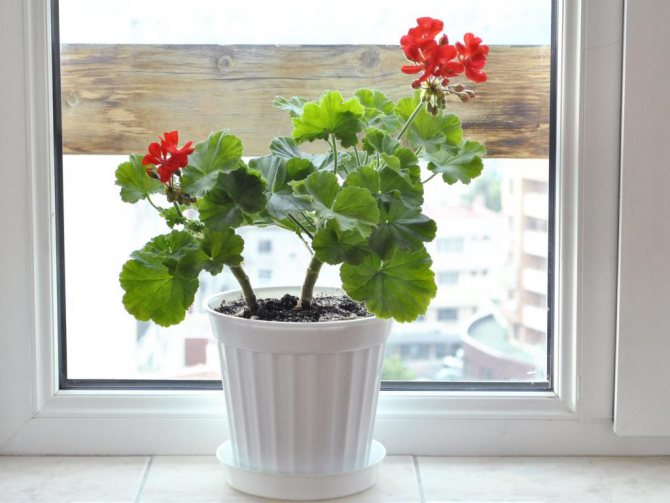

But growing geraniums in full shade is also not worth it. In this case, the most beautiful thing you will see on it are small leaves. Even with all its desire, without natural light, pelargonium will not be able to please you with abundant flowering.
Minerals for Abundant Geranium Blossom
For a beautiful flowering, special feeding is not needed.
For good flowering, the plant is provided with the following elements:
- potassium;
- nitrogen;
- phosphorus.
Abundant flowering will provide watering of the flower with water and iodine. As previously mentioned, nitrogen mixes are kept to a minimum during flowering.
In addition to the main elements, they provide the following minerals:
- manganese;
- zinc;
- magnesium sulfate;
- copper;
- boron;
- phosphorus;
- calcium;
- iron.
Experienced gardeners recommend using calcium supplements to keep the plant growing healthy.
Top dressing
In no case should organic fertilizers be used to feed geraniums. It is best to saturate the soil with mixtures of potassium, phosphorus and nitrogen in equal proportions.
Feeding geranium with potassium, you will definitely wait for its flowering. But be sure to control its amount in the fertilizers used - it should not be too large.
Proper care of pelargonium involves saturating the soil:
- calcium;
- zinc;
- manganese;
- copper;
- iron;
- magnesium;
- boron.
For this, it is best to use ready-made houseplant fertilizers. For example, the use of "Merry Flower Girl" or "For Flowering Plants" mixture would be a great option.
If it's hot outside, do not feed the geranium - it will be stressful for her. First, transfer the plant to the shade, and only then add fertilizer to the soil. In this case, do not forget to water the flower in advance.
It is advisable to feed pelargonium twice a month. Nutrition is especially important for her in spring and summer.
Essential vitamins and minerals for growth
Pelargonium, like any other home flower, gets all the nutrients it needs for its life from the soil.
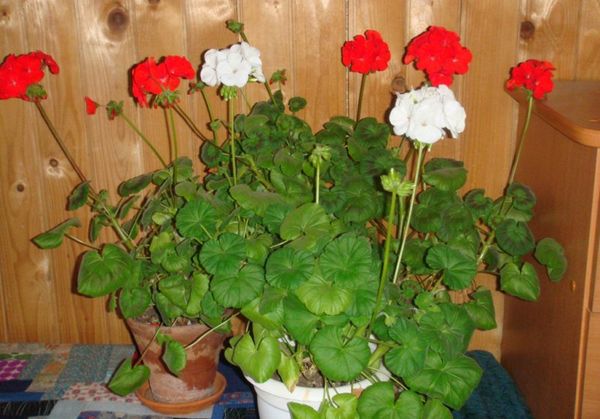

In order for geraniums to bloom for a long time and beautifully, the earth must contain the following trace elements:
- manganese;
- nitrogen;
- boron;
- potassium;
- copper;
- calcium;
- zinc;
- iron;
- phosphorus.
If the soil is depleted in at least one trace element, then the flower will show various deviations in flowering until it stops completely. In addition to the substances described above, pelargonium needs vitamins of group B for abundant flowering. It should be noted that for the beginning of flowering of pelargonium, there is not enough simple feeding.The flower should grow in optimal conditions for itself. The pot should be placed on a sunny and open area of the windowsill. Watering pelargonium should be rare, but abundant.
Geranium breeding methods
To obtain new flowers, you can use cuttings and dividing tubers. Moreover, the latter method is in demand for the propagation of garden plants, although, if desired, you can use it at home.
But why do this if you can get a new bush by simply cutting off the cuttings? They need to be harvested in the spring.
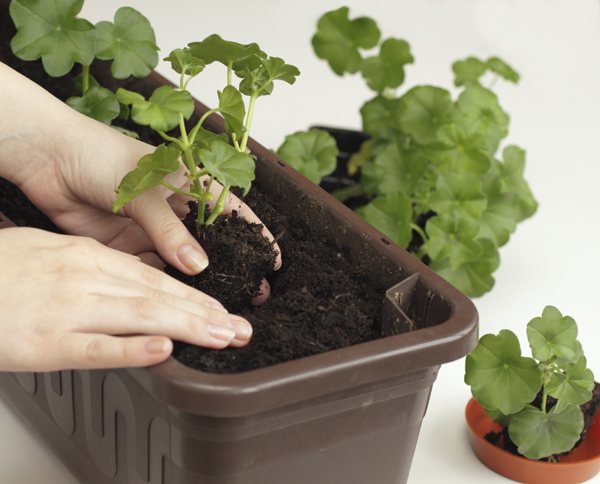

How to plant geraniums? To do this, shoots cut from the top of the pelargonium should be placed in water. Keep in mind: there should be at least 3-4 leaves on the shoot.
At normal temperatures, cuttings grow roots very quickly. After that, the shoot can be moved to a pot with soil. Just before you transplant the cutting into the soil, let it dry after water. Once it starts growing in the pot, pinch off the top.
Now you know how to plant geraniums as easy as possible. If you do everything right, then a large beautiful bush will grow from a small shoot in just a few months, which will immediately delight you with its luxurious flowers.
How to feed geraniums at home?
To feed geraniums, it is not necessary to go to special stores and buy expensive fertilizers. Some of them can be made at home from improvised means. The main thing is to observe the dosage.
| Name of funds | Description |
| Peroxide | The plant is sprayed with a solution of hydrogen peroxide. This method is used if the plant is weakened. Treatment relieves disease. Preparation:
|
| Yeast | If you feed the geranium with yeast, it will accelerate growth and strengthen the general condition of the plant. Yeast is a fungus that enters the soil and stimulates the production of potassium and nitrogen. How to cook:
|
| Milk | Geranium is fed with milk solution. It is alternated with regular watering. Preparation:
|
| Glucose | For rooting, the sprout is fed with a glucose solution. The solution is not suitable for everyone, royal geranium does not like glucose. If the geranium leaves turn yellow and wilted, then it is recommended to stop feeding. To prepare the solution, you must:
|
| Castor oil | Castor oil stimulates the growth of any plant. To feed the geranium dilute a teaspoon of castor oil in a liter of water. Such a solution is sprayed onto the leaves of the plant or the root is poured. These nutrients are brought in during bud formation or flowering. |
How to transplant geranium
In fact, pelargonium is one of those plants that can easily do without transplanting. But be that as it may, its condition should be checked periodically. A transplant may be required for geraniums when there is no room for its roots in the pot.
Most often, it is necessary to transplant pelargonium already in adulthood. Although this procedure may be necessary for the plant if you regularly flood it with water.
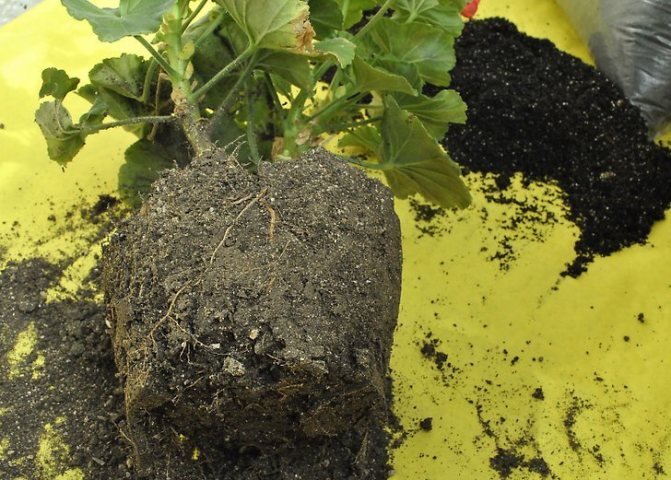

In any case, to move geraniums, you should choose a small flowerpot that will not differ much in size from its predecessor. When choosing a tub, take into account the volume of the plant's root system.
Be sure to place drainage on the bottom of the pot. Geranium grows well even in regular garden soil, but you can indulge it by making a more nutritious mixture by hand. To do this, mix in equal proportions humus, sand, leaf and turf soil.
Transplanting geraniums is best in spring.
Tips from experienced florists
- If the leaves turn yellow and wither, and a fungus also appears, then this is a sure sign of excess moisture. Therefore, the advice is - it is better to leave the soil dry than to water it again. Pelargonium can easily endure drought, overflow can destroy it.
- Pelargonium does not like spraying, this makes it easier to care for it.
- At home, you need to put a flower on the south window, on the site - choose the warmest sunny place. Pelargonium is native to Africa and loves warmth and light very much.
- The temperature should not be allowed to drop below +12 ˚C, otherwise it will stop blooming.
- Pelargonium loves milk. If you periodically water the bush with a solution of milk and water in a ratio of 1: 7, then the trunk and leaves will strengthen.
- If the leaves turn pink, do not worry, this is normal. You can call it a kind of tan.
- The first time after transplantation, the leaves of the pelargonium may crumble, the trunk may remain completely naked. Don't worry, this is a normal response to stress. After acclimatization in a new place, the plant will grow foliage again.
- In order for pelargonium to bloom even more abundantly in the middle of the season, it is imperative to remove dry and faded inflorescences.
- If the indoor flower does not bloom, then the reason may be in an oversized pot. Pelargonium does not need a lot of space and soil, it grows well, even when the roots have filled the entire volume of the pot. Therefore, during planting, you need to take a small pot with a diameter of about 10 cm.
- For active growth of peduncles and abundant flowering, it is recommended to plant several ornamental bushes nearby or in one box.
- The wintering of geraniums must be cool (the temperature of the content is not higher than +12 ˚C). This will greatly affect the flowering of the next season. In addition, in winter, the flower does not need to be fed, it should be watered no more than 1 time in 10-15 days.
Experienced gardeners know how simple and convenient pelargonium is, the care and reproduction of this plant does not cause much trouble. It is necessary to give this plant a little care and attention, and it will respond with abundant flowering and a lush attractive crown. In this case, it does not matter where the flower grows: in a pot or in a flower bed, the basics of care are the same.
Iodine solution with hydrogen peroxide
A solution consisting of iodine and peroxide allows you to cope with a variety of problems, including:
- elimination of bacteria;
- prevention of root decay;
- acceleration of flower growth.
Before watering the plant with fertilizer, you need to remove damaged leaves and parts, and also slightly loosen the substrate. This will bring air to the root system.
How to do it?
To prepare the solution, take the following components:
- settled water - 1 l;
- iodine - 0.6 ml;
- hydrogen peroxide - 1 ml.
Mix everything thoroughly and use for watering geraniums.
Action on growth and flowering
The iodine-based solution not only stimulates flowering, accelerates the formation of ovaries, but also helps the plant to fully develop, especially in spring and autumn.
Besides, iodine improves the absorption of nitrogen by the plant, and this has a positive effect on the growth of green mass and strengthening the immunity of geraniums against diseases such as late blight and powdery mildew.
Risks and Potential Consequences
Watering geranium with iodine solution can only be done after moistening the soil... If this is not done, then the roots will get burned, and the plant will die. For the rest, the solution is completely safe if the dosage and application rules are correctly followed.
How to cook without peroxide?
To prepare an aqueous solution, you need to take 1 liter of water and 1 drop of iodine. Stir and use for watering geraniums.
How to water?
The process of fertilizing a flower involves observing the following steps:
- After preparing the solution, water the soil with geraniums with plain water.
- Wait until it absorbs and gradually pour in the iodine solution.
- Pour only at the root, as the flower will not tolerate foliage moisture.
- One pot will take 50 ml of solution.
- Perform surgery every week.
If something went wrong
Very often, when iodine feeding is applied, the solution falls on the leaves of the flower. In this case, it is urgent to remove it with soft matter. If you leave everything as it is, then the leaves will begin to wither or dry out.
Similarities and differences of species
Both flowers are assigned to the Geraniev family. The total number of studied species is about eight hundred. Outwardly, the flowers are very similar, however, studies have shown obvious differences. The main evidence is the impossibility of crossing. The biggest difference is in the areas of plant growth. Pelargonium is a thermophilic flower, it is comfortable in the southern lands and warm apartments. Geranium is more cold-hardy and unpretentious, capable of growing at low temperatures in forests and meadows of the northern hemisphere. Grows well in gardens and parks, does not require shelter for the winter.
The stems and leaves of plants are the same, but the flowers are different.
In geraniums, they are formed by five or eight single petals, rarely gather in inflorescences. Pelargonium is distinguished by the corolla of the flower: two larger petals protrude upward, three small ones are located below. The flowers themselves are formed into large inflorescences. There are also differences in color. For example, geranium cannot be scarlet, and pelargonium cannot have bluish tints.
So, geranium is a garden plant, pelargonium is an indoor plant. Since the first name is most often used, we will not deviate from it either. We will talk about an indoor flower, although we will call it both "names".
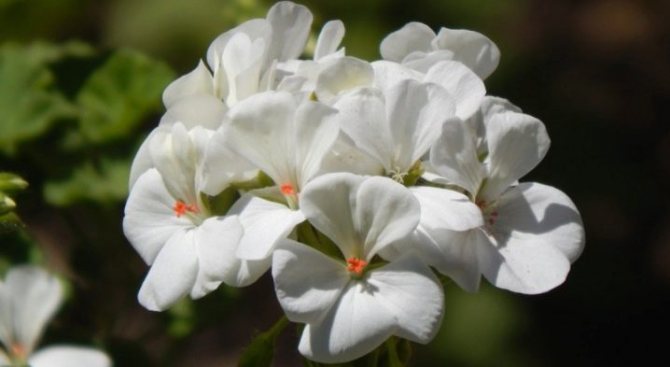

The nature of the princess
The one who is able to knock out a novice geranium grower is royal pelargonium. Typical problems with it look like this: a person buys an already flowering bush, happily carries it home, admires lush, double flowers for about a month. And then the pelargonium fades. "Pauses" - as its owner thinks. Waiting for a year. Then the second one. And - nothing happens, the geranium does not want to bloom
The fact is that the content of the royal geranium has its own nuances, to which ordinary geranium, ampelous and star-shaped geraniums are indifferent.
- In winter, during the dormant period, royal pelargonium must be kept at a temperature of 16-18 degrees.
- Water it in small doses, but every day! And it is better, if the tips of the roots are visible in the drainage holes in the bottoms of the pots, pour water into a tray, from where the royal person herself will extract as much as she needs.
- Unlike other geraniums, with distrust of organic fertilizers, the royal uses them with pleasure. They are especially important for her during the awakening period.
- She doesn't like drafts.
- Nitrogen feeding after waking up is a must! But it is also necessary to add a small amount of magnesia sulfate to the soil.
If these conditions are met, royal geraniums will definitely bloom in the spring!
How to prepare the solution?
For the preparation of the nutritional formula required:
- hydrogen peroxide (you do not need to stock up on the composition, it will certainly be found in your home medicine cabinet);
- iodine;
- settled water at room temperature;
- syringe or pipette for accurate determination of constituents;
- container with a lid for mixing the components.
The need for water is 1 liter, for iodine - 0.6 ml, and hydrogen peroxide - 1 ml.
The proportions cannot be violated! An overabundance of ingredients will only harm the flower.
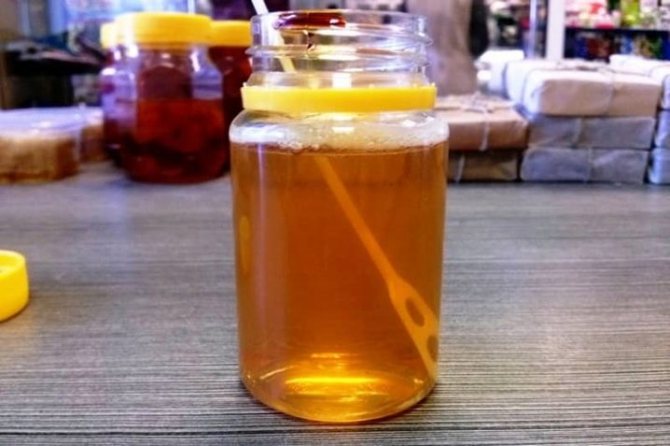

In the absence of a graduated instrument (beakers, syringe, pipette), the dose can be determined in drops. There are 23 drops in 1 ml of hydrogen peroxide, and 48 drops in 1 ml of iodine. Through simple calculations, we obtain the required number of drops of iodine 48 x 0.6: 1 = 28.8 drops.
Correctly measured ingredients should be thoroughly mixed until a homogeneous mixture is obtained. If iodine is used without hydrogen peroxide, then only one drop will be needed per liter of water.It is very important not just to water the flower with a nutrient solution, but to do it right. Otherwise, you can cause significant damage to the plant.
It's easy to remember the rules. First, the lower dried leaves are removed from the plant, access to the ground is freed. The second stage is the preparation of the nutrient solution. After that, the earth is loosened and thoroughly moistened. Thorough moistening is not meant to be sprinkled with a large volume of water, but by the expectation of complete absorption of the poured liquid.
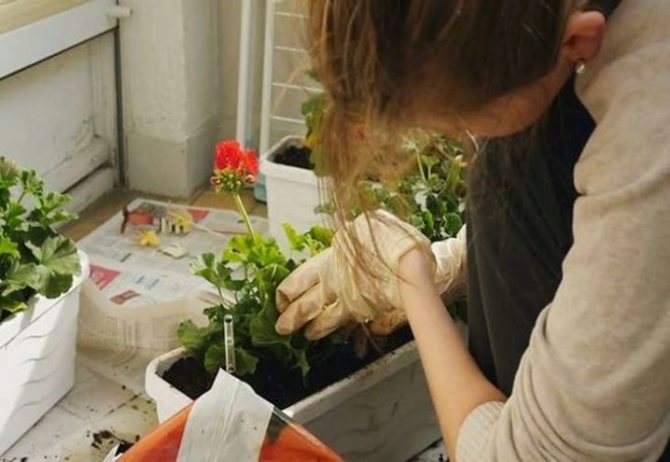

After thorough preparation of the soil, top dressing is introduced into it from a solution of iodine and hydrogen peroxide. The dose of the solution per plant is no more than 50 ml. If the solution is poured on dry ground, the roots of the flower will be damaged. They will literally burn out from the caustic "drink".
Watering must be carried out carefully, excluding drops of solution falling on the leaves. If, nevertheless, a few drops do get on green vegetation, they should be immediately blotted with a soft cloth or napkin. And then it is advisable to rinse the sheet with water. Untreated leaves dry up and fall off.
Compliance with the rules of watering, and the exact dosage of the solution will make your geranium the most beautiful indoor plant.
The next video explains why geraniums need iodine.
How to fertilize?
Here you will find an overview of what you can use to fertilize geraniums for abundant flowering.
Shop options
In a specialized store today you can find various fertilizers for indoor flowers. For example, there are products that are perfect for all home flowering plants: "Universal" - 350 rubles for 500 ml, "For flowering plants" - 60 rubles for 250 ml. But for proper feeding of pelargonium, it is preferable to use special preparations created specifically for this flower.
- Dry granular and powder fertilizers, such as "TerraSol" - 150 rubles for 2.5 kg or "Clean sheet for pelargoniums" - 55 rubles for 350 grams, are used to prepare aqueous solutions. It is easy to do this at home, observing the proportions indicated on the package. These fertilizers are convenient because they can be stored for a long time and do not take up much space.
- Liquid dressing Is, as a rule, a concentrated solution of salts and vitamins. For example, "Garden Club" - 20 rubles for 250 ml and "Agrecola" - 110 rubles for 250 ml. These concentrates are diluted with water. According to the proportions indicated on the label. Their advantage over dry fertilizers is that there is a complete dissolution of the substance and no sediment is formed.
Natural
Also, experienced flower growers use natural products as a top dressing for pelargonium. Let's consider them in more detail.
- It has a very beneficial effect on pelargonium milkbecause it contains a lot of calcium, potassium, phosphorus, magnesium, sodium, amino and fatty acids. To prepare top dressing for 1 liter of water, you need to take 100 grams of fat milk.
- All flower growers love to use as top dressing. yeast solutioncooked at home. Since this agent can replace the heteroauxin preparation, the action of which is aimed at the development of the root system of pelargonium. For 1 liter of water, 100 grams of dry yeast is taken - for rooting cuttings. Or in 1 liter of water, 3 grams of yeast and 2 tbsp. tablespoons of sugar - for root bait.
- Sugar helps feeding better digestion. For example, with the preparation "Baikal EM-1" you can use the following solution: for 1 liter of water, take 2 tbsp. tablespoons of granulated sugar.
- Ash serves as an excellent source of potassium, calcium, magnesium, zinc and iron for pelargonium flowers during their flowering period. To do this, 1 tbsp is diluted in 1 liter of water. spoon of wood ash.
- Eggshell used as a source of calcium in the form of an infusion for the soil. So it is used as a drainage.
The use of iodine
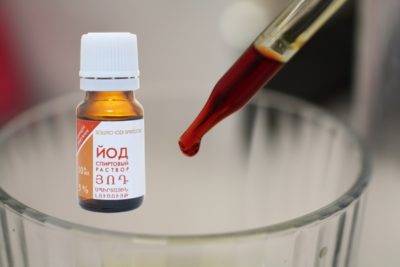

To enhance the growth and abundant flowering of pelargonium and other indoor plants, iodine solution is successfully used. It is very simple to prepare this liquid fertilizer: take only 1 drop of iodine per 1 liter of water. Then take 50 grams of the resulting mixture and gently pour it in a circle along the sides of the pot. This precaution is necessary in order not to burn the delicate roots of the plant. Abundant flowering will begin after periodic watering of the flower.
Now you know how to feed geraniums for abundant flowering.
Watch a video about feeding pelargonium (geranium) with iodine solution:
Transfer
Geranium does not tolerate a transplant, so you can change the flowerpot only if the "room" expands and when the roots are exposed. If the roots get cramped, the plant stops blooming. To check the freedom of space for the roots, you need to carefully pull the flower out of the pot.
The transplant is carried out in early spring, from late February to April. If you transplant geraniums in winter, it will take root less well. If transplanting is not expected, you can simply periodically update the top layer of the potting soil.
If you have your own front garden, you can transplant geraniums into open ground in the spring. In the fall, the plant is returned to the pot, separating the "children".
Before transplanting, the pot is treated with bleach or manganese solution to prevent the transfer of diseases. If you transplant a plant from one container to another, the ground is moistened first, and then the geranium is removed. If the plant is difficult to remove, you can knock on the bottom and walls of the flowerpot with your hand.
Note! When transplanting, try not to damage the root system.
After the transplant, the flowerpot is installed in a darkened place and only after a couple of weeks is placed on the windowsill. Fertilizing for geraniums after transplantation is applied after a couple of months.
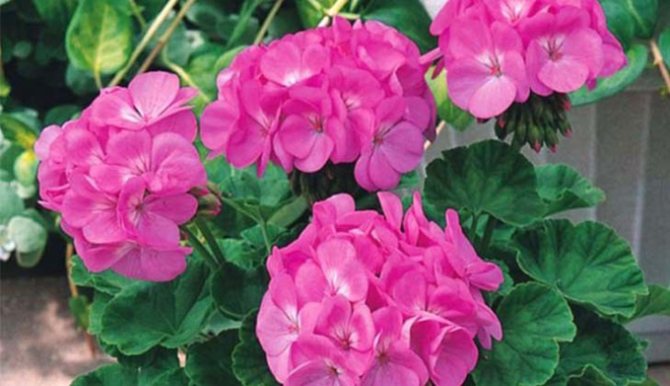

The need for a transplant
Some amateur flower growers believe that constant feeding of the plant replaces the transplant. Is it really? This is an incorrect point of view, as the flower grows in size, and it needs a more spacious container.
Planned transplantation into new soil should be carried out annually. This is necessary to renew the composition of the soil mixture, even in spite of regular feeding. Sometimes an emergency flower transplant is necessary if it suddenly falls to the floor or is flooded with water.
How to transplant geraniums correctly? Florists are advised to do, instead of transplanting, transshipment to another container, since the plant is difficult to tolerate the procedure. The earth is pre-saturated with nitrogen and magnesium sulfate. If the land is taken from the garden, it is necessary to add all the necessary mineral complex before moving the geranium into the container. In the flower shop, you can buy long-acting granular mixtures - they ensure the constant flowering of indoor geraniums. The granules are simply mixed with the soil mixture; when water enters, they gradually release nutrients to the roots.
Boric acid
Boric acid solution is able to increase the number of buds several times and extend the flowering period. To prepare it, it is enough to dilute 0.5 g of boric acid powder in a small amount of very warm water so that the crystals can dissolve. After the resulting concentrated mixture is diluted with 1 l of water.
Experts do not recommend fertilizing plants with boric acid more than 2 times per season, since with its frequent use, the flower can get burned.
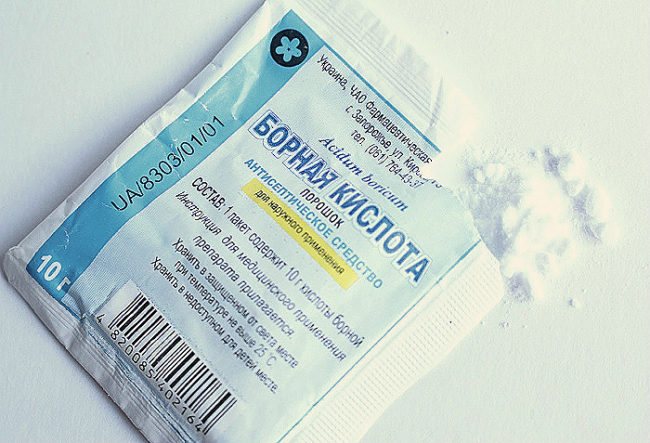

Fertilization rules
If you adhere to the simple rules of fertilization, then geranium will always be healthy and beautiful.
For lush bloom
To achieve abundant flowering, you need to provide the plant with nutrients such as potassium, nitrogen and phosphorus. In order for geranium to bloom at home, it is worth ensuring the presence of such elements in the soil as:
When forming buds or at the beginning of flowering, it will be useful to use calcium for feeding.It is necessary to sprinkle the soil in which the geranium grows, with eggshell, previously ground, or with chalk.
Do not forget to sometimes water it with a few drops of iodine. This method is fairly simple and cheap. When the geranium has faded, you can immediately start watering with iodine. This method can be used even in January. It is enough to use such a solution once every 2 weeks.
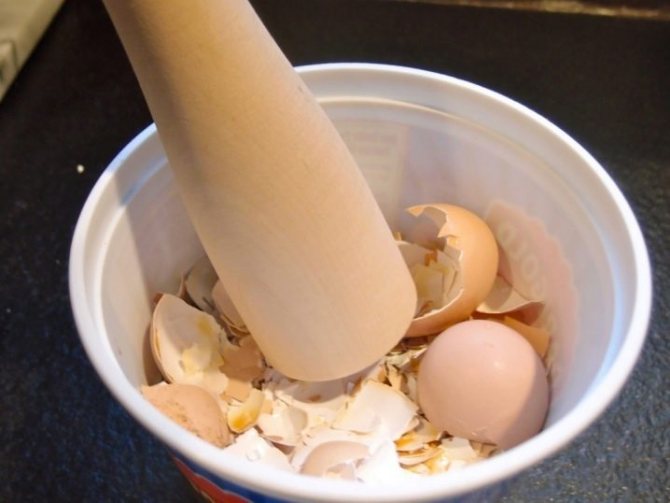

Plant growth and active flowering are often stimulated by a castor oil solution. You only need to add 1 teaspoon of oil to 1 liter of water. Geranium should be fed by watering at the root or spraying the leaves. Gardeners recommend using rainwater for irrigation, since it has more nutrients than ordinary water.
Useful video
Why do geraniums need iodine? More details in the video below:
If you find an error, please select a piece of text and press Ctrl + Enter.
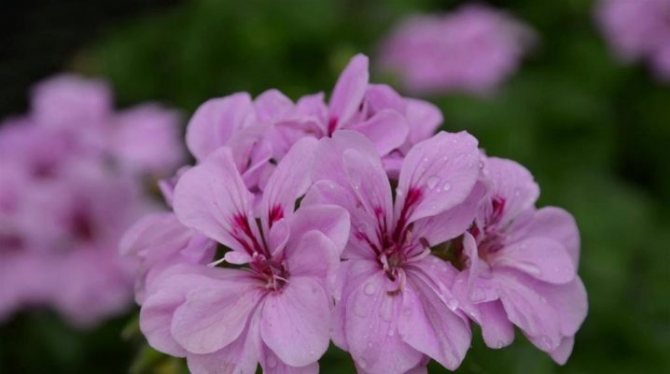

Before talking about how the feeding of geraniums with iodine affects the flowering of a plant, you should understand the name of the flowers. The vast majority of amateur gardeners do not consider it necessary to delve into botany, so it is often believed that geranium and pelargonium are one and the same flower.
It is believed that pelargonium is a scientific name, and geranium is a household name. Hence the confusion.
When and why do you need to feed the plant?
Healthy geranium, subject to a comfortable temperature regime and regular feeding with nutrient complexes, blooms frequently and abundantly. If any of these conditions are not met, the flower may not bloom for years.
Lack of nutrients makes the flower weak, vulnerable, he stops producing buds. The room pet begins to hurt. This is reflected in its appearance - the leaves will become pale and lethargic, and will grow more slowly. In a neglected situation, the leaves can dry out and fall off. If appropriate measures are not taken in time, then a bare trunk will remain of the beloved flower.
In order to prevent burns on the roots, be sure to water the soil before feeding.
If the geranium has been in the sun for a long time, it is better not to feed it. Intense heat is stress for a houseplant. Move the flower to a shady place for at least an hour. A slightly rested pet should then be watered and only after that fertilizer should be applied.
What is iodine for?
The number of flowers will increase if you feed the plant with magnesium sulfate a couple of times during the summer. But most growers choose a different method. They mix two ingredients: regular pharmacy-bought iodine and hydrogen peroxide.
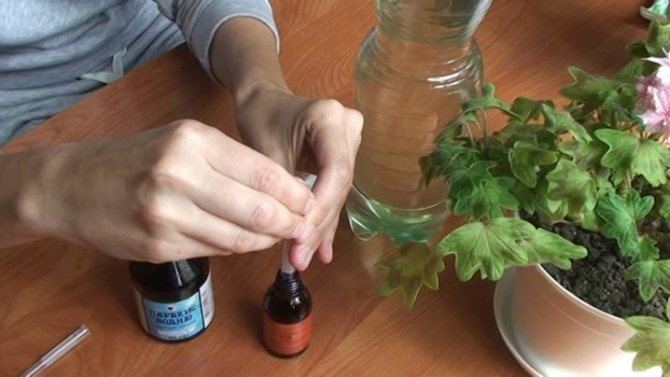

A solution of three elements (the third is water) weakened or unwilling to bloom geraniums are watered once every 7 days.
The described solution is very useful for an indoor flower. It strengthens the root system significantly. Strong roots provide the plant with nutrition, which is immediately visible: the leaves become larger, their color is brighter.
It is impossible not to notice how the appearance of the flower changes:
- his colors are saturated;
- the appearance of ovaries is accelerated;
- the number of buds increases;
- flowers are enlarged;
- the flowering period is extended.
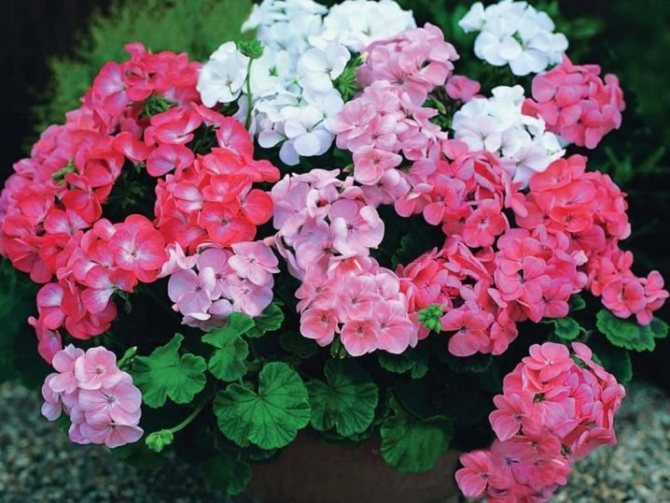

Like real "living water", the mixture works wonders. It destroys bacteria that appear on the plant, helps to fight diseases, protects the root system from decay. The flower fertilized with iodine transforms, shows all its advantages, all the brightness of colors, all the tenderness and irresistibility.
It is not worth using such fertilizer too often. If the plant is doing well, you can be content with regular watering.
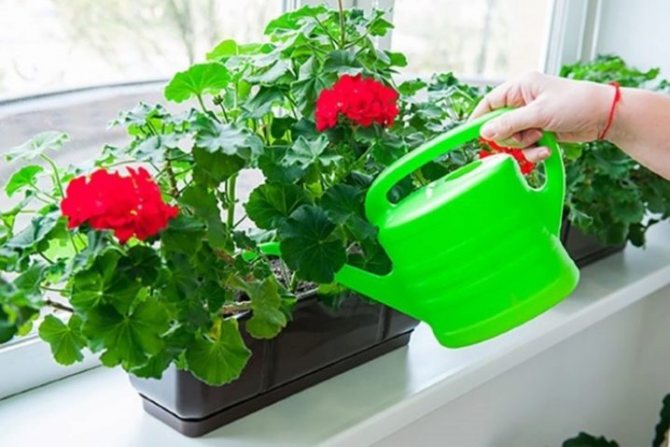

Pruning and reproduction
Flowers can be propagated by cuttings, seeds and roots. The seeds are purchased in flower shops and planted in the soil pretreated with potassium permanganate in early March. To plant seeds, the soil is loosened in containers and seeds are scattered on top. You do not need to deepen the seeds into the soil, but only sprinkle them with earth on top.Next, the container is covered with plastic wrap to create the necessary microclimate and placed in a warm place. Well-strengthened sprouts are transplanted into separate flowerpots.
To form splendor, the bush is cut off, leaving stems 20 cm long.
Cuttings with three or four leaves are first placed in a container of water until the roots grow. Then the cuttings are transplanted into flowerpots, after drying them from moisture. For better adaptation of cuttings to the ground, solutions of heteroauxin and glucose are used - growth and flowering stimulants. In some cases, a solution of nettle or yeast is used.
Specialists' recommendations for feeding geraniums
The health of pelargonium and high-quality flowering will help ensure simple fertilization rules:
- If the flower has been for some time under improper lighting, it is undesirable to feed it. First, correct the situation, and then, after a day, start feeding.
- Do not rush to prepare fertilizers if geranium leaves begin to fall: the reason is different. General lethargy and rotten places on greenery appear with excessive watering, dry edges - with a lack of moisture. Also, falling off occurs due to a lack of light.
- After spreading the fertilizer, thoroughly loosen the area around the stem to allow air to return to the ground.
- You can not feed the flower more than 1 time per week. The optimal interval is 2 weeks. Do not add anything for 14 days before transplanting. After the transplant, take another pause (7 days).
- For young plants, the dosage of any product should be halved.
- For winter feeding geraniums, only half of the norm of stimulants is needed.
Potassium and phosphorus are key elements for a good flowering crop. Geranium also needs nitrogen, but it has a depressing effect on flowering. Therefore, with the appearance of the first flowers, the nitrogen dosage should be approximately halved in relation to phosphorus and the amount of nutrients should be compensated for by potassium.
And a little about the secrets of the Author
Have you ever experienced unbearable joint pain? And you know firsthand what it is:
- inability to move easily and comfortably;
- discomfort when going up and down stairs;
- unpleasant crunching, clicking not on their own;
- pain during or after exercise;
- joint inflammation and swelling;
- unreasonable and sometimes unbearable aching pain in the joints ...
Now answer the question: does this suit you? How can you endure such pain? And how much money have you already "poured" on ineffective treatment? That's right - it's time to end it! Do you agree? That is why we decided to publish an exclusive interview with Oleg Gazmanov, in which he revealed the secrets of getting rid of joint pain, arthritis and arthrosis.
Attention, only TODAY!


